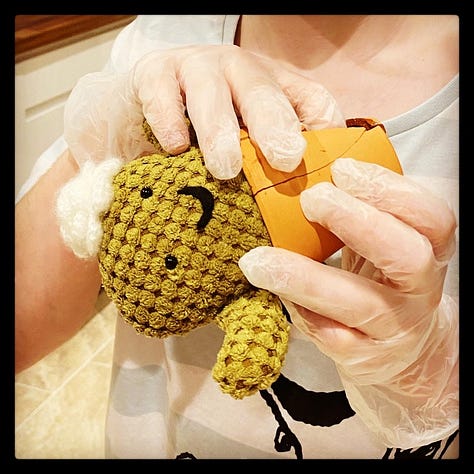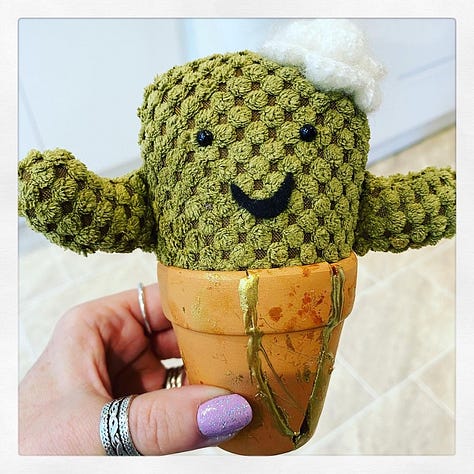Exclusive: Breaking Waves Chapter 6
Tits, Bums, Lumps and Bumps (and a HUGE surprise for me)
The big surprise
Well today has come around and unexpectedly knocked me right off my feet, but with the most wonderful of landings. Breaking Waves is actually available for pre-order on the Waterstones website! (In the UK anyway). I wasn’t expecting it yet, I thought it would be a few more weeks, but here it is! The Amazon link isn’t yet live but I will share this as soon as it is.
I haven’t stopped shaking since I came across it about an hour ago. I am properly giddy, and struggling to speak in coherent sentences. Fortunately this post largely contains content from the book which is much more coherent, so you’re safe from the waffle!
I will continue to share my weekly excerpts as the pre-order options increase and we start hurtling towards actual publication in March 2025.
I have previously shared excerpts from Chapter 1: The Shape of Water, Chapter 2: The Taste of an Iceberg, Chapter 3: Drowning, Chapter 4: The First Breath and Chapter 5: The Body Keeps the Score. Today I would like to introduce you to Chapter 6: Tits, Bums, Lumps and Bumps.
This is for you 🌊💕
Chapter 6: Tits, Bums, Lumps and Bumps
I love this chapter. This is partly because it follows on from 3 chapters which cover such profound subject areas (death, birth, mental health), and partly because there is just a lot of joy in this exploration of learning to love our bodies. Chapter 6 looks at the conditioning behind our feelings about body image, and how the water is so powerful in changing this narrative. From sauna culture to swimwear, shame to acceptance, it’s all in here.
I chose this excerpt because I love this notion of our bodies telling our stories, and because well, we all love Bob the Happy Cactus.



I hope you enjoy it, I’d love to hear your thoughts 🫶
”There is a Japanese word, kintsugi,[i] which has increasingly come to prominence in recent years. Translated literally it means ‘to join with gold’, but to the Japanese it is ‘a broader philosophy of embracing the beauty of imperfection’. The concept originated in the art of repair; not discarding broken crockery, but piecing the fragments back together with tree sap, and coating the sticky joins with powdered gold, thus allowing the piece to celebrate its cracks, to show its story in all its glory. When I first heard of this a few years back I was utterly delighted by the notion, and bought myself a kintsugi set, which very soon came into its own. My youngest daughter, Charlotte, has always been quietly obsessed with succulents – she has a six-foot artificial cactus called Cornelius in her bedroom that always came on campervan holidays with us – it drove my husband nuts. One Christmas morning, when she was about six years old, her big sister, mini-baby-Bel, gave her an overstuffed fabric cactus with a very cute face, squished into a ceramic pot. She delightedly named him Bob the Happy Cactus, carrying him around with her all of Christmas day, until he inevitably slipped from her fingers, the pot shattering on the kitchen floor. The heartache was real. We retrieved the fragments, and with the aid of the kintsugi set, Charlotte painstakingly put Bob back together, with pieces missing and askew, but whole nonetheless, gold powder generously hugging the thick lines of gooey paste, and coating everything else in sight. We all love Bob more than ever; he is imperfectly perfect and he is indeed a very happy cactus.
For so many of the women I have met, our kintsugi is in and around the water. It is the place where we slowly repair and heal our wounds, where we learn to celebrate our bodies, to wrap ourselves in gold thread and allow ourselves moments of self-acceptance, and dare I say it, self-love. In the water we reveal the story of our bodies, we present ourselves at our most vulnerable, but the really interesting thing is that nobody else is looking. It’s our story, for us alone, and one in which we can rejoice in the wonder of what our bodies are and what they can do. How we shriek in the joy of being tussled by waves, gasp at the firing of all our receptors as we dip in ice pools and can float silently in balmy waters leaving our troubles behind. It is a place for self-compassion. I can’t speak for swimming pool culture, but in the open water, the body as the container is not relevant, what matters is presence, and just ‘being’. The connection is with nature and the environment, not with how we look. I have had the emotional experience of sharing the lake naked on a summer’s evening with a woman who was coming to terms with her body following a mastectomy. Arms raised above her head as she entered the water, I wasn’t looking at her chest, I was mesmerised by her smile and the cheeky twinkle in her eye as she took back a tiny bit of control over the body that had temporarily betrayed her. I have swum alongside someone battling terminal cancer, because despite the ravages her body was going through, it still enabled her to swim. Where the body lets us down, it can also lift us up. This is what I love.”
[i] https://www.bbc.com/travel/article/20210107-kintsugi-japans-ancient-art-of-embracing-imperfection#:~:text=But%20the%2015th%2DCentury%20practice,helps%20us%20accept%20our%20flaws
Chapter 7 excerpt next week…if you like this please do share! It means the world 🙏
And if you would like to support my writing but don’t have the capacity to upgrade right now, you can always buy me a cuppa. With my eternal gratitude 🫖🫶
As always
Love & lemons 💕🍋
Em xx






What happy news for you and us! And I love Chapter 6 with your perfect illustration of kintsugi.
March is right around the corner and I will place my Amazon USA order as soon as it appears.
xx
Yay!!! 🙌🏻 🌊 ✨💫